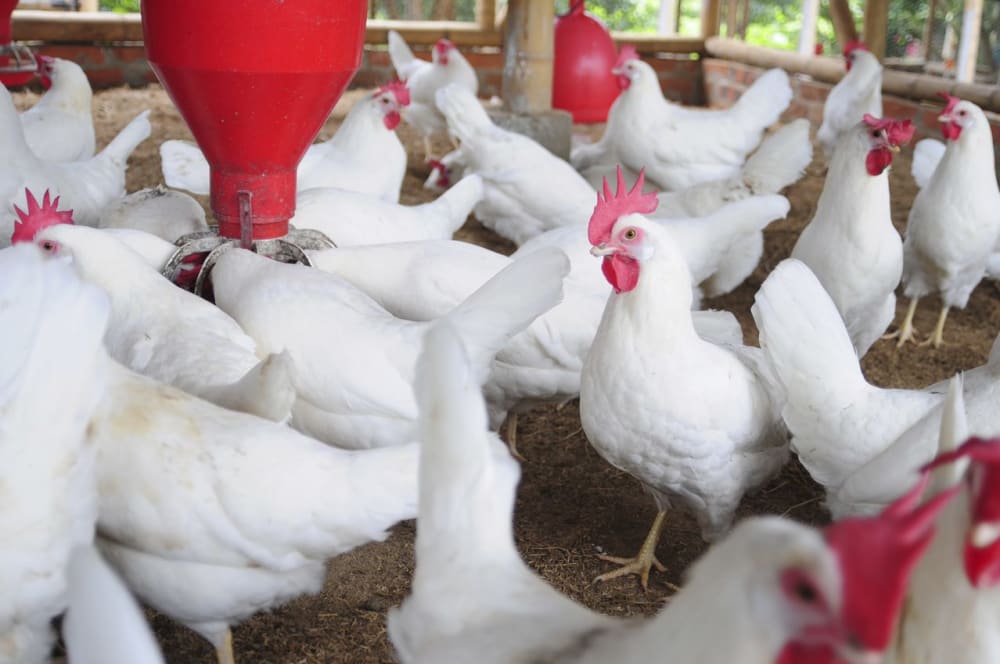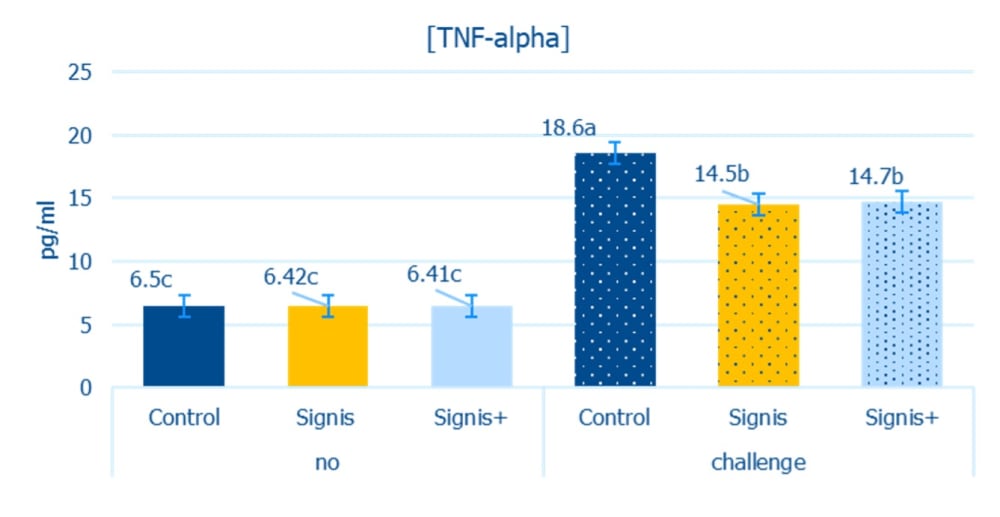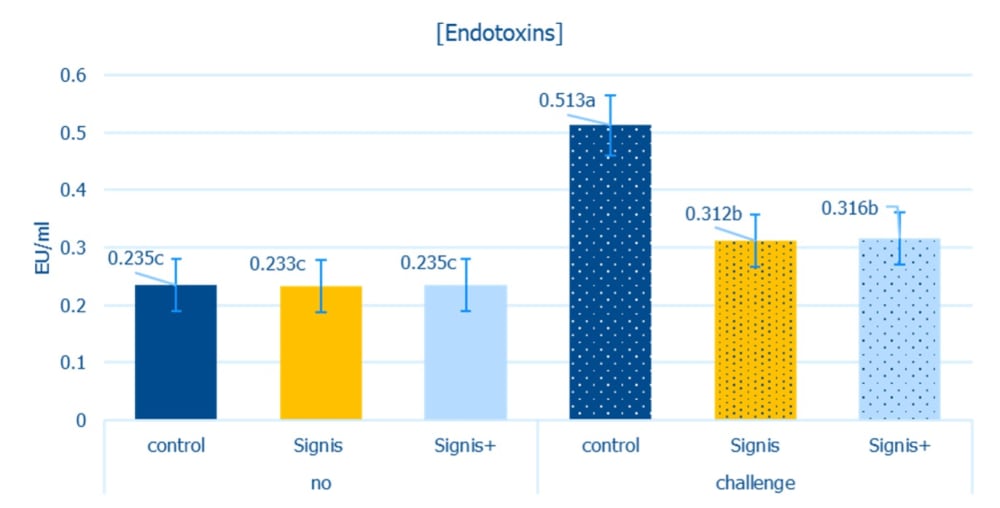Gut health is key to animal performance
Published Tuesday, 20th December 2022By Xaviere Rousseau - AB Vista Global Poultry Technical Manager
This article was first published in Feed Compounder magazine - https://www.feedcompounder.com/
It’s commonly said that the gut is the ‘second brain’ – and for good reason. Gut health is essential to optimising animal performance, increasing productivity and boosting profitability. Therefore, ensuring good gut integrity and functionality should be a primary objective for producers to achieve a productive flock.
With the livestock sector looking to reduce antibiotic usage, the challenge facing all producers is how to continue to effectively prevent and control disease. Given its impact on the immune and physiological functions of the animal, a healthy gut is central to this.
It is well known that gut health affect an animal’s overall productivity. Poor gut health can lead to less nutrient absorption, energy losses, gut integrity damage and dysbiosis. Which is why a healthy, functioning gut is a pre-requisite to enabling an animal to express its full genetic potential.
But what is good gut health? It is a combination of good intestinal function and gut integrity. The intestine provides the first line of protection against pathogens due to its interactions with gut microbiome and immune system cells; and the physiological structure allows for the uptake of essential nutrients and immune sensing while restricting pathogenic molecules and bacteria.
Digestion and the microbiome
One of the main functions of the gut is, of course, digestion. Efficient digestion aims to provide absorbable nutrients required by the animal that can transit to the metabolic part and play a full role.
To achieve this, and to make the feed more valuable for the animal, there has to be the right balance of nutrients, and ensuring a reduction of undigested fraction. Key is limiting undigested protein arriving in the distal part of the gut while including specific fermentable fibre that can be fermented to benefit gut integrity and function.
There is a strong link between the digestion process and the intestinal microbiome, which plays a crucial role in determining and maintaining the health and performance of an animal.
For decades, it has been known that host–microbiome symbiosis in ruminants is crucial for meeting essential energy and nutrient needs and, more recently, the importance of this symbiosis has been acknowledged in monogastric species. Even though the nutritional strategies of non-ruminants are different from those in ruminants, the gut still plays an integral role when it comes to the immune and physiological function, nutritional and health status of the animal, and overall performance.
For example, many of the challenges pig producers face – such as reducing dysbiosis and post-weaning diarrhoea, optimising growth performance, and feed efficiency – are linked to the gut microbiota and can be addressed through its management and modulation.
Fibre as a functional ingredient
Due to the shift away from antibiotic growth promoters (AGP), alternative nutritional strategies are being widely examined.
Fibre plays a pivotal role. However, the optimum level needed is dependent on several factors, namely: the animal’s age and the compartment of the gut. Moreover, fibre type, content and their ratio to undigestible protein is also crucial to keep carbohydrate fermentation going through the distal gut, while avoiding harmful bacteria and toxic compounds production.
Fibre, as defined today, has both a chemical and physiological definition. Chemically, fibre refers to all non-starch polysaccharides (NSPs) plus lignin, which consists of macromolecular polymers of monosaccharides joined by a specific type of linkage called a glycosidic bond. Physiologically, dietary fibre is the edible parts of plants or analogous carbohydrates (polysaccharides, oligosaccharides, lignin, and associated plant substances) that are resistant to digestion and absorption in the small intestine with complete or partial fermentation in the large intestine (AACC, 2001).
NSPs are often referred to as soluble or insoluble, so being able to evaluate these fractions helps us to understand or predict their physiological effects within the animal and optimise their use in feed formulation. While we are still discovering the benefits of fibre, the wet chemistry methods for hydrolysing fibre into their monomeric components are laborious, time consuming and expensive.
However, AB Vista has developed a full NIR (Near Infra-Red) Spectroscopy Service, with a calibrations database of more than 400,000 global reference samples and over four million spectra. These calibrations can rapidly determine the NSPs within cereals and protein feed ingredients, providing producers with reliable, real-time data that enables them to predict fibre content of feedstuffs and optimise feed formulation.
Determining fibre content and characteristics can therefore support producers in reducing the anti-nutritional effects that some of these components have, as well as provide an appropriate substrate for the beneficial bacteria to ferment.
The role of additives
To achieve a healthy gut, it is imperative to establish a stable, functional microbiome with a level and type of fermentation beneficial to the animal. A balanced microbiome is obtained when carbohydrate fermentation predominates over protein fermentation, as the former produces volatile fatty acids (VFAs), such as acetic, propionic, and butyric acid, which affect gut health and the overall metabolism of the animal.
There are a variety of different feed additives available as an alternative to AGPs to stimulate and maintain a healthy gut. They include prebiotics, probiotics, organic acids, phytobiotics/essential oils, enzymes, and stimbiotics - and they all vary widely in their nature and mode of action.
Beyond fibre, age is another important factor to be taken into consideration as there is a close relationship between fibre, the microbiome, and the biological age of the animal. Developing a highly active fibre-fermenting microbiome as early as possible to degrade fibre more efficiently is therefore a useful tool to maximise animal performance and reduce the incidences of harmful pathogens.
Stimulating the establishment of a fibrolytic microbiome producing VFAs will provide a multitude of benefits, including lowering hindgut pH levels, provide energy to maintain the enterocytes, modulate the mucosal immunity and preventing pathogen attachment. And it is this mechanism that forms the basis of the stimbiotic concept.
Stimbiotics
As chickens and pigs age, their gut microbiota gets better at degrading and fermenting fibre. However, stimbiotics have been demonstrated to favourably stimulate the microbiota fermentative capacity. Because they can have a beneficial effect at very low dosages they are not considered as a ‘prebiotic’, by definition.
The effect of dietary fibre in the lower gut depends on their type and characteristics, as they can be utilised by different bacteria and therefore stimulate different fermentation pathways. Provision of a stimbiotic product, has been shown to improve piglet performance, gut integrity and microstructure while reducing inflammation and E coli count, with further improvement not observed when including a probiotic.
Stimbiotic supplementation can, therefore, provide performance gains at the same time as improving gut health and animal resilience to the different challenges they may face in regular commercial production.
Moreover, stimbiotic supplementation was shown to be even more efficient than prebiotics in increasing VFA content in the faeces and reducing plasma pro-inflammatory cytokines in piglets, especially when placed in poor sanitary conditions, as well as improving performance.
Similar results were observed in broiler chickens when placed in an induced Necrotic enteritis challenge where birds supplemented with a stimbiotic were as resilient to challenges to gut integrity, inflammatory response and growth performance as birds fed with a combination of prebiotic, probiotic, and phytogenic products (Figure 1).
Figure 1. Effect of a stimbiotic alone (Signis) or in combination with prebiotic, probiotic, essential oil, and yeast mannan (Signis+) compared to a control diet without any additive (control) in induced necrotic enteritis challenge (challenge) or not (no) on [TNF-alpha] as a marker of the inflammatory response and [Endotoxins] as a marker of gut integrity
Conclusion
It is clear that the role of dietary fibre in achieving optimal gut function is even more valuable than initially thought. Exploring new opportunities that fibre may offer in monogastric nutrition is key to gaining a better understanding of the beneficial bacteria that ferment fibre.
Considering fibre represents a significant proportion of any diet, it seems reasonable to harvest the benefits, such as improvements in animal performance and health, that fibre fermentation yields. As has been demonstrated, these can be achieved with stimbiotics and functional feed additives that target the fibrolytic microbiome.
Latest news
Stay ahead with the latest news, ideas and events.

Online Feed Fibre Calculator
Calculate the percentage of dietary fibre in your feed
Our calculator is designed for nutritionists and uses averages of global raw materials to calculate the dietary fibre content (plus other more in-depth fibre parameters) of finished animal feed. These parameters are available within AB Vista’s Dietary Fibre analysis service (part of our NIR service).
Sign up for AB Vista news
A regular summary of our key stories sent straight to your inbox.
SUBSCRIBE© AB Vista. All rights reserved 2025
Website T&Cs Privacy & Cookie Policy Terms & Conditions of Sale University IDC policy Speak Up Policy



























